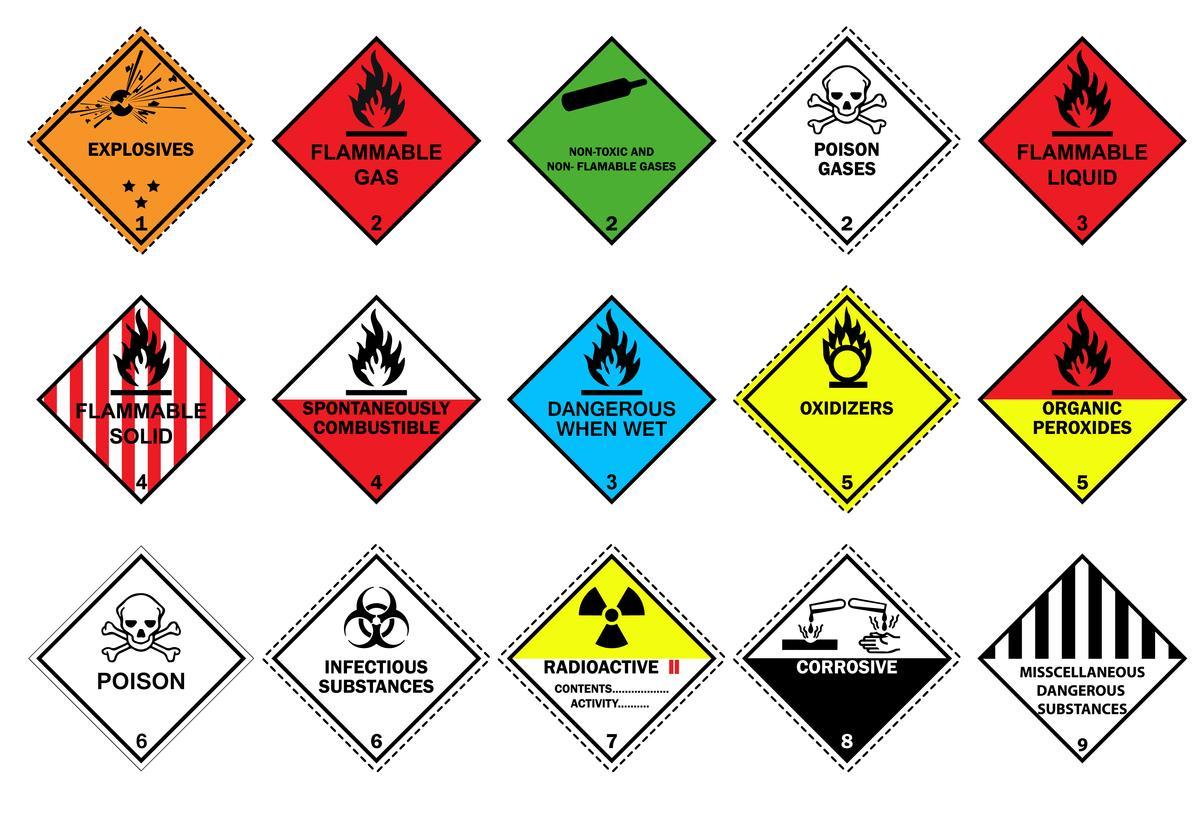1. What are dangerous goods?
Dangerous goods are the goods that contain dangerous substances during transportation, which are substances and items with explosive, flammable, toxic, infectious or corrosive properties.
This type of goods has the potential to cause harm to life, human health, the environment, safety, and national security and needs to be packaged, stamped, labeled, and handled carefully during transportation.
2. Classification of dangerous goods
Based on the characteristics, physical properties, chemical properties, the dangerous goods are divided into 9 groups:
Group 1: Explosives and explosive items.
Including potentially explosive substances and materials. For example, fireworks, flares, etc.
Depending on the level of reaction, the explosives are divided into 6 small divisions:
- Division 1.1. Substances and articles with a wide explosion hazard.
- Division 1.2. Substances and articles that have a splash hazard but do not explode widely.
- Division 1.3. Substances and articles that present a fire hazard and a small explosion or splash hazard or both, but not widespread explosion.
- Division 1.4. Substances and articles that pose a significant risk.
- Division 1.5. The substance is very insensitive but has a wide explosion hazard.
- Division 1.6. Special items are not sensitive, there is no risk of widespread explosion
Group 2: Gases
Including compressed, liquefied or dissolved gases under pressure. For example, gas cylinders, fire extinguishers, etc.
- Can be divided into divisions:
- Division 2.1 Flammable gases
- Division 2.2 Non-flammable and non-toxic gases
- Division 2.3 Toxic gases
Group 3: Flammable liquids and desensitized liquid explosives.
For example, paints, oils, gasoline, alcohol, etc.
Group 4: Flammable solids, explosive desensitized solids, self-reactive, self-igniting substances and substances that in contact with water produce flammable gas
They are substances that are flammable or capable of spontaneous combustion; substances that, when in contact with water, emit flammable gases.
For example, phosphorus, sulfur, matches, etc.
There are 3 divisions for class 4 dangerous goods:
- Division 4.1: Flammable solids, self-reactive substances and solid explosives immersed in liquid or desensitized.
- Division 4.2: Substances capable of spontaneous combustion.
- Division 4.3: Substance that in contact with water produces flammable gas.

Figure 1: Classification of dangerous goods
Group 5: Organic and oxidizing oxide compounds
Divided into 2 divisions:
- Division 5.1 Oxidizing agents
- Division 5.2 Organic Peroxides
They react easily with other flammable or combustible materials, meaning a fire can break out and continue in confined spaces. For example, fertilizers, lead nitrate, etc.
Group 6: Infectious and toxic substances
This group is also divided into 2 divisions:
- Division 6.1 Toxic substances. Such as pesticides.
- Division 6.2 Infectious substances such as blood test solutions, medical tests, etc.
Group 7: Radioactive substances
Group 8: Corrosive substances
These substances have a high potential to cause decomposition reactions, damaging transport vehicles and other objects, and on the other hand, they also destroy living cells.
For example: bleach, batteries,…
Group 9: Other dangerous substances and articles
Including dangerous substances outside the 8 divisions mentioned above.
To know which group the goods belong to, you can rely on section 14 of the Transport information of the Material Safety Data Sheet (MSDS) or on the label affixed to the goods.
- Packages and containers containing dangerous goods that have not been cleaned inside and outside after unloading all dangerous goods are also considered corresponding dangerous goods.
3. Packaging, containers, packaging of dangerous goods
- Packaging, containers and packing of dangerous goods within the territory of Vietnam must comply with national standards (TCVN) or national technical regulations (QCVN) corresponding to the type of goods.
For types, groups of dangerous goods that do not have national standards or national technical regulations, regulations of specialized management ministries or apply international standards and technical regulations issued by the Line Ministry.
- The line ministries announce international standards and regulations on packing, containers, and packaging of dangerous goods applicable to types, groups of dangerous goods managed by the Ministry.
4. Labels, danger logos and signs
- Labeling of dangerous goods is carried out in accordance with the Government’s regulations on goods labeling.
- On the outside of each package or container containing dangerous goods, there is a danger logo and danger signal attached in an easy-to-observe position. Dimensions, symbols, and colors of danger logos are according to the prescribed form.
- The orange yellow rectangular danger signal has the UN code (United Nations code) written in the middle. Dimensions of danger signs are according to the prescribed form. The location of the danger sign is below the danger logo.
For the fastest advice and support, please contact TGI TRANS Customer Care Department directly.
